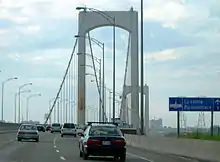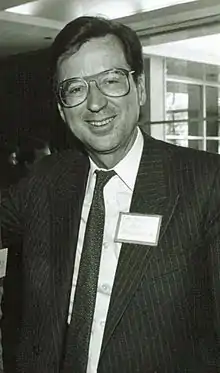Pierre Laporte
Pierre Laporte (25 February 1921 – 17 October 1970) was a Canadian lawyer, journalist and politician. He was Deputy Premier of the province of Quebec when he was kidnapped by members of the group Front de libération du Québec (FLQ) terrorist group during the October Crisis. When the FLQ's demands were refused, they executed him. Laporte's body was found in the trunk of Paul Rose's car, one of the kidnappers.
Pierre Laporte | |
|---|---|
 | |
| Deputy Premier of Quebec | |
| In office 1970–1970 | |
| Member of the National Assembly of Quebec for Chambly | |
| In office 1961–1970 | |
| Preceded by | Robert Théberge |
| Succeeded by | Jean Cournoyer |
| Personal details | |
| Born | 25 February 1921 Montreal, Quebec, Canada |
| Died | 17 October 1970 (aged 49) Quebec |
| Resting place | Notre Dame des Neiges Cemetery |
| Political party | Liberal |
| Spouse(s) | Françoise Brouillet |
Life and career
Pierre Laporte, grandson of the Liberal politician Alfred Leduc, was born in Montreal, Quebec, on 25 February 1921. He was a journalist with Le Devoir newspaper from 1945 to 1961, and was known for his crusading work against Quebec's then-Premier Maurice Duplessis. During his years in journalism, he published a number of series targeting the management of the Duplessis government. In 1954, Le Devoir ran a six-part series on problems during the construction of the Bersimis-1 generating station.[1] In 1958, he was part of a team of Le Devoir reporters exposing the natural gas scandal,[2] leading to the formation of the Salvas Commission, soon after the election of 1960.
After Duplessis' death, Laporte successfully ran for a seat in Chambly in the Quebec National Assembly and served in the government of Premier Jean Lesage. Laporte was a member of the Quebec Liberal Party, and considered to be a leading member of the party's left wing. After Lesage announced in 1969 that he would step down as party leader, Laporte ran to succeed him, but lost the 1970 Quebec Liberal Party leadership election to fellow cabinet member Robert Bourassa.
After the Quebec general election in 1970, Premier Bourassa advised the Lieutenant Governor to appoint Laporte as Deputy Premier, Parliamentary Leader, Minister of Immigration, and Minister of Labour and Manpower.[3]
Kidnapping
On 10 October 1970, Laporte was kidnapped from his home on Robitaille Street[4][5] in Saint-Lambert, Quebec, by the Chénier Cell of the FLQ.[6] The kidnappers – Paul and Jacques Rose, Francis Simard and Bernard Lortie[7] – approached Laporte while he was playing football with his nephew on his front lawn and forced him into their vehicle at gunpoint. They dubbed him the "Minister of Unemployment and Assimilation," and held him hostage, demanding the release of 23 "political prisoners" in exchange for his freedom.[8] British diplomat James Cross was also being held hostage by the FLQ at the time, having been kidnapped on 5 October (Cross survived the experience, and was released on 3 December).
Prime Minister Pierre Trudeau invoked Canada's War Measures Act which allowed mass raids and arrests to take place in order to find the group who had kidnapped Laporte and Cross. Trudeau said:
Nothing that either the Government of Canada or the Government of Quebec has done or failed to do, now or in the future, could possibly excuse any injury to either of these two innocent men. The gun pointed at their heads have FLQ fingers on the trigger. Should any injury result, there is no explanation that could condone the act. Should there be harm done to these men, the Government promises unceasing pursuit of those responsible.[9]
On 17 October, seven days after he went missing, Laporte's body was found in the trunk of a 1968 Chevrolet Biscayne at Montreal Saint-Hubert Longueuil Airport. His kidnappers were subsequently captured and sentenced for his murder, and served terms ranging from 20 years to life.[10] Laporte was buried in the Cimetière Notre-Dame-des-Neiges in Montreal, Quebec.
In 2010, journalist Guy Gendron produced a documentary series for Radio-Canada, in which he asserted that the killing of Pierre Laporte was unintentional – "Il a été étouffé dans un moment de panique [He was strangled in a moment of panic]".[11][12]
Possible mafia connections
According to an ex-agent of the Surêté du Québec, Claude Lavallée, prior to Laporte's death at the hands of the FLQ, he was suspected of having an association with well-known Montréal underworld figures, Frank Cotroni and Frank Dasti.[13] This is cited as the reason why Laporte was not offered a portfolio in the Bourassa government. Due to his unexpected death and the unusual circumstances surrounding it, there was no further investigation of Pierre Laporte's alleged mafia activities.[14]
Monument to Laporte
On the 40th anniversary of his death, 17 October 2010, a monument to Laporte was unveiled by then-Premier of Quebec, Jean Charest. It stands at the St. Lawrence Seaway Park, near Laporte's home on Robitaille Street.[15] On the monument is inscribed: "Nul ne vit pour soi-même. Nul ne meurt pour soi-même" ("No one lives for oneself. No one dies for oneself").[16]
See also
- List of people who disappeared
References
- Landry, Richard (February 2009). Le projet d'aménagement de la rivière Bersimis, 1952-1956 (PDF) (in French). Université du Québec à Montréal. pp. 87–90.
- Gingras, Pierre-Philippe (1985). Le Devoir. Montréal: Libre-Expression. p. 165. ISBN 2-89111-204-0.
- "Pierre LAPORTE (1921-1970)"
- "Un monument à la mémoire de Pierre Laporte inauguré à Saint-Lambert". La Presse (in French). 17 October 2010.
- Leonardo, David (20 October 2010). St-Lambert Journal. Saint-Lambert, QC. Missing or empty
|title=(help) - Krajicek, David. "The FLQ and the Quebec October Crisis". truTV. Retrieved 16 July 2013.
- Bauch, Hubert (November 30, 1996). "From the Archives of 1996: When to Forgive? For the Most Part FLQ Terrorists have become Model Citizens". Montreal Gazette.
- "On This Day – 1970: Canadian minister seized by gunmen". BBC. Retrieved 16 July 2013.
- "1970 Year in Review: Canadian Kidnappings, Vietnam trials". UPI.com. Retrieved 16 July 2013.
- Bélanger, Claude (23 August 2000). "Chronology of the October Crisis, 1970, and its Aftermath". Quebec History — Marianopolis College.
- Gendron, Guy. "Révélations sur la mort de Pierre Laporte" (in French). Radio-Canada.ca. Retrieved 16 July 2013.
- MacPherson, Don (28 September 2010). "Extremist makeover – the FLQ edition". The Montreal Gazette. Archived from the original on 1 October 2010.
- https://www.journaldemontreal.com/2013/03/20/pierre-laporte-corrompu?fbclid=IwAR0MZ9bw8yP2RLxbfmJQzFAnd6BzP66KM4ke63V0JvNy8pDwl8E6kb1L-BU
- Lavallée, Claude, Révélations d'un espion de la SQ, Éditions de l'Homme, Montréal, 2012.
- "Pierre Laporte's death during October Crisis marked by monument". CTV News. 17 October 2010.
- "Un monument à la mémoire de Pierre Laporte inauguré à Saint-Lambert". La Presse.ca (in French). 17 October 2010.
External links
- "Biography". Dictionnaire des parlementaires du Québec de 1792 à nos jours (in French). National Assembly of Quebec.
- Pierre Laporte at Find a Grave
| National Assembly of Quebec | ||
|---|---|---|
| Preceded by Lucien Cliche (Liberal) |
Minister of Municipal Affairs 1962–1966 |
Succeeded by Paul Dozois (Union Nationale) |
| Preceded by Jean Cournoyer (Union Nationale) |
Minister of Labour 1970–1970 |
Succeeded by Jean Cournoyer (Liberal) |
| Preceded by n.a. |
Government House Leader 1965–1966 |
Succeeded by Maurice Bellemare (Union Nationale) |
| Preceded by n.a. |
Official Opposition House Leader 1966–1970 |
Succeeded by Rémi Paul (Union Nationale) |

